by W.S. Cranshaw* (1/19)
Quick Facts…
- Root weevils can be common insects that develop on roots of many garden plants.
- Adult root weevils chew distinctive notches along the edges of leaves at night.
- Some kinds of root weevils often wander into homes but cause no injury indoors.
- Insecticides applied on the lower trunk and branches can be used to control leaf feeding by adult root weevils.
- Soil drenches of certain entomopathogenic nematodes can be used to control root weevil larvae
A root weevil is a type of “snout beetle” that develops on the roots of various plants. Adult stages produce more conspicuous plant damage, cutting angular notches along the edge of leaves when they feed at night. Adult root weevils also may attract attention when they wander into buildings, acting as a temporary “nuisance invader”.
The most common root weevils found in Colorado are strawberry root weevil (Otiorhynchus ovatus), rough strawberry root weevil (O. rugostriatus), black vine weevil (O. sulcatus) and lilac root weevil (O. meridionalis). Dyslobus decoratus is established in some areas and chews leaves of various shrubs. Two small root weevils that sometimes wander into buildings are hairy spider weevil (Barypeithes pellucidus), and Trachyphloeus asperatus. Several other species likely occur in the state as root weevils are easily moved in nursery stock.
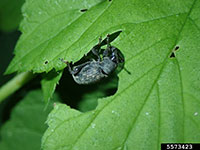
Figure 1: Black vine weevil feeding on hops plant at night. |
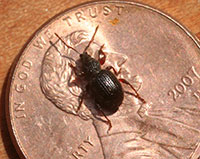
Figure 2: Strawberry root weevil feeds on many different kinds of plants. They also can be common nuisance invaders of buildings, particularly during hot, dry weather. |
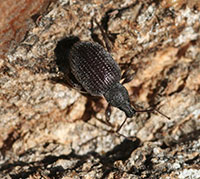
Figure 3: Rough strawberry root weevil. |
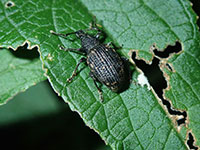
Figure 4: Black vine weevil. |
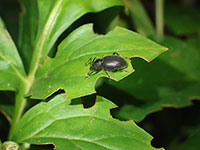
Figure 5: Lilac root weevil and associated leaf notching on peony. |

Figure 6: Dylobus decortatus feeding on buckthorn. |
Life History and Habits
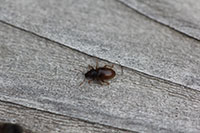
Figure 7: Hairy spider weevils attract attention when they wander in buildings. |

Figure 8: Trachyphloeus asperatus is a small weevil that sometimes occurs indoors. The host plants for this insect are not known. |
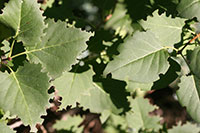
Figure 9: Leaf notching of lilac produced by lilac root weevil. |
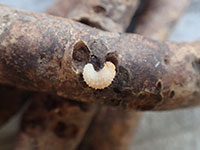
Figure 10: Larva of lilac root weevil feeding on roots of peony. |
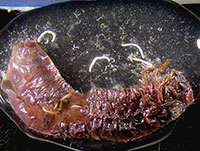
Figure 11: White grub killed by the Heterorhabditis nematodes. This entomopathogenic nematode causes the infected insect to have a reddish-brown color. Photograph courtesy of David Shetlar, The Ohio State University. |
The life history for black vine weevil and strawberry root weevil have been most studied and likely have life histories similar to that of other common root weevils. A one year life cycle is normal for all species. With few exceptions, winter will be spent as a larva, in the soil, feeding on roots when temperatures allow. Larvae of root weevils are legless grubs, with a cream-colored body and a pale orange-brown head. In late winter and early spring, larvae complete development and then transform to the pupal stage, which also occurs in the soil. Most adult root weevils emerge in mid to late spring. Some species (e.g., black vine weevil, strawberry root weevil) produce only females and reproduce asexually. Others, such as lilac root weevil, produce males and females.
None of the root weevils can fly and they are night active, hiding during the day around the base of host plants, usually under a bit of cover. About an hour after sunset they become active and crawl onto the plants to feed on leaves, producing their characteristic angular notches. If disturbed, root weevils will readily drop from plants and play dead.
Adults typically live for at least a couple of months, and some may be present into autumn. Most eggs are laid in late spring and early summer with females squeezing eggs into soil cracks. A few days after they are laid, eggs hatch and the larvae move to the roots where they feed.
Plant Injury by Root Weevils
Leaf notching by the adults is the only injury that is easily observed. Several kinds of plants may be fed upon by each of the different kinds of root weevils and two or more kinds of root weevils may be present in a garden. Searching the plants at night is the best means to determine what species is present.
Lilac root weevil is most often found feeding on lilac, privet, peony and euonymus. Euonymus, Heuchera, Astilbe, hosta, creeping jenny, peony and wisteria are among the common hosts of black vine weevil. Strawberry root weevil also has a very wide host range that includes strawberry, raspberry, rhubarb, white clover, dandelion, dahlia, and mint but it has also been reported to feed on many kinds of trees and shrubs, chewing on the roots and bark at the base of the plant. Rose, strawberry, raspberry, gooseberry, and cotoneaster are among the hosts of rough strawberry root weevil. Cherry and buckthorn are among the more common hosts of Dyslobus decoratus. Hairy spider weevil is reported to feed on several types of trees and shrubs (cherry, elm, hawthorn, oak) as well as many common herbaceous plants, including some weeds (aster, dandelion, ragwort, thistle). The host plants for Trachyphloeus asperatus are unknown.
As root weevil adults normally travel only short distances, it is likely that larvae are developing on plants that show injury by adults. However, that may not always be the case and larval injury can only be confirmed by digging plants to expose the larvae feeding on roots. This is best done in autumn and early spring when larvae are more full-grown and easily seen. Severe root pruning by larvae can potentially cause plants to decline and dieback, but this is rarely observed in landscape plantings.
Control of Root Weevils on Plants.
Adult root weevils can be controlled with sprays of several kinds of pyrethroid insecticides such as permethrin, bifenthrin, cyfluthrin, or cyhalothrin. These are best applied on the lower trunk of the plants and around the base of the plant to kill the weevils as they climb. If the plant is flowering and attracting pollinators, sprays should not be made to leaves and flowers. If plants are not in bloom it may be useful to spray lower leaves as well as the lower trunk and branches. Sprays made late in the day, shortly before the insects become active may improve effectiveness.
“Beneficial nematodes” (entomopathogenic nematodes) can be used as a soil drench treatment to control root weevil larvae in soil. (See fact sheet 5.573, Insect Parasitic Nematodes for more details.) Several species of these nematodes are commercially available, all via mail order, but those in the genus Heterorhabditis (e.g., Heterorhabditis bacteriophora) are most effective for control of root weevil larvae. These would be most effectively applied after most eggs have hatched and when soil temperatures are warm. For most root weevils this would be during the summer months, typically between mid-July and mid-September. The nematodes are applied as a drench to the soil and the treated area should be watered to keep the soil moist.
Root Weevils as Nuisance Pests in Buildings
Some root weevils will incidentally wander into buildings at certain times of the year. This most often happens with strawberry root weevil, which most frequently invades homes during periods of hot, dry weather in late June and July. The hairy spider weevil and Trachyphloeus asperatus also tend to wander into buildings in early summer. During late summer and early autumn black vine weevil and rough strawberry root weevil are more commonly observed indoors.
Inside homes, the root weevils cause no injury to humans or household furnishings. Their occurrence is solely as a temporary nuisance invader that will not reproduce indoors. When root weevils are present often the best course is to tolerate the occasional beetles, vacuuming them as they are observed. Left alone, root weevils will either die out on their own or migrate back outdoors and infestations of buildings tend to be short-lived.
Migrations indoors are best prevented by sealing openings of the building that allow root weevils (and other insects) access to the interior. Root weevil numbers may also be reduced by removing plants around the outside of the home on which the insects feed. Reducing watering around building foundations may also limit appearance of root weevils within buildings, as the adult insects appear attracted to shade and moisture.
There is no effective use of insecticides applied indoors for reducing root weevils. Insecticides applied on the building exterior that target cracks and other points of potential insect entry may further suppress the incidental migration of root weevils into buildings.
* W.S. Cranshaw, Colorado State University Extension entomologist and professor, bioagricultural sciences and pest management. 1/00. Revised 1/19.
Colorado State University, U.S. Department of Agriculture and Colorado Counties cooperating. Extension programs are available to all without discrimination. No endorsement of products mentioned is intended nor is criticism implied of products not mentioned.
Go to top of this page.





